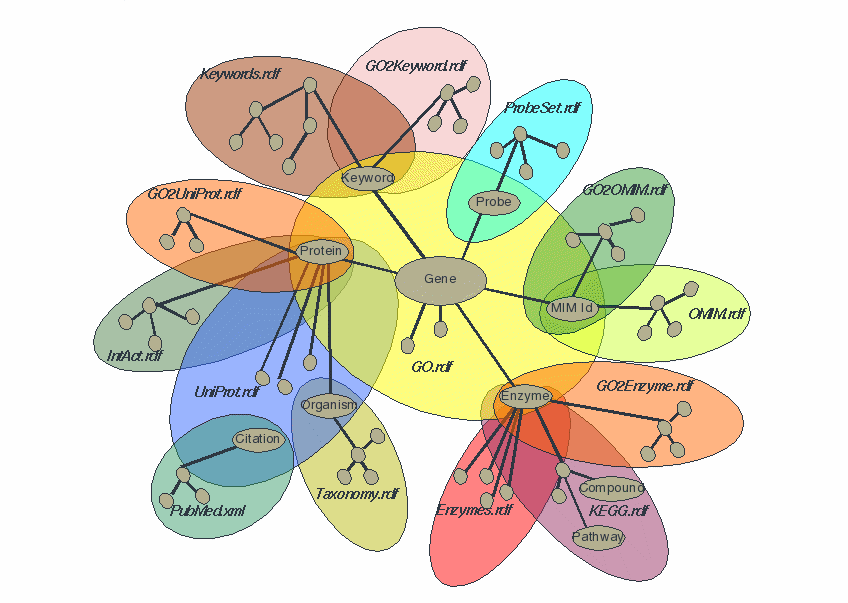Web Future
http://www.w3.org/2007/Talks/1003-webfuture-tbl/
Tim Berners-Lee
MIT Computer Science & Artificial Intelligence Laboratory (CSAIL)
World Wide Web Consortium
2007-10-03
Looking back
- Remember back before the Web?
- the fundamental change: Universality
- Spirit of Web development
Pre-Web
now difficult to explain what it was like!
- Documentation systems do not work together
- Attempts to unify fail from imposing too much
- Difficult to explain what WWW will be like
CERN: The European Particle Physics Laboratory

CERN: Atlas Detector

Pre-web at CERN
Need to bridge
- People from all over the world
- Different sorts of information
- Different organizations
1980: Enquire
> ENQUIRE
Enquire V 1.1
Hello!
Opening file (PSK-PCP)VAC-V1:ENQR...
PSB Vacuum Control System (concept) < O>
--- ------ ------- ------
[ 1] described-by: Enquiry System
An experimental system for which this is a test.
[ 2] includes: Vacuum History System
Records and displays slow changes in pressure.
[ 3] includes: Vacuum equipment modules
Perform all the hardware interface
[ 4] includes: Control and status applications programs
Provide operator interaction from the consoles.
[ 5] described-by: Controle du System a Vide du Booster 11-2-80
Operational specification of the software
[ 6] includes: PSB Pump Surveillance System PCP 228
Allows rapid monitoring of pressure changes
[number ]
Solution
- Make minimum requirements of adopters
- Abstract space includes all conceivable systems
- Universal space
1989: Web memo
Circles and arrows again...
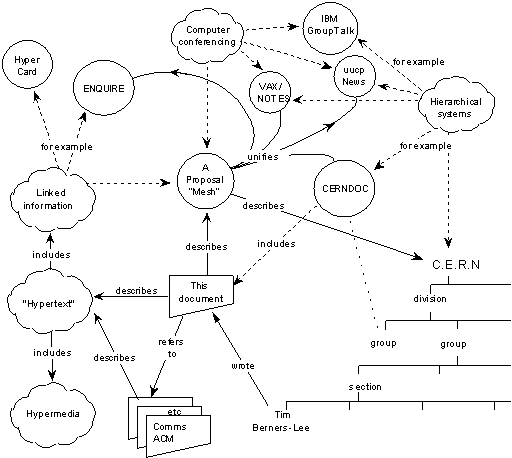
1990: WWW design
- URI is global identifier, having one is good
- URI schemes have different properties
- HTTP scheme allows publish and lookup
- HTTP allows many data formats
- HTML is a language for hypertext
- .. but links not typed.
1990: Original WWW architecture

Universality of the Web
independence of:
- Hardware platform
- Software platform - OS
- Application Software
- Network access
- Public, Group, or Personal scope
- Scribbled idea to polished publication
- Language and culture
- Disability
- Data for machines or Documents for people
Web essential: Layering
- Internet designed independent of application
- Email, FTP, Web, Voice, ...
- Web designed independent of application
- Browsing, shopping, participating, searching...
- Foundation vs. Ceiling technologies
- Open royalty-free standards
- Clean interface makes no assumptions
- Flexibility points
1991-4: Paradigm shift
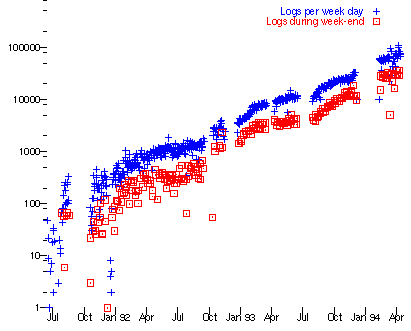
1994: World Wide Web Consortium
good + fair + fast
- Industry and academic and public participation
- Wide review
- Implementation Interoperability requirements
- Coordination between groups
- Internationalization, Accessibility
- Royalty free standards -> safe, wide adoption
- Many activities, check
w3.org
- Join!
Leading the web to its full potential
Care and use of the WWW
- URIs should be persistent - don't change them!
- Make sure your site is accessible
- Insist on open standards
Spirit of Web design
has been the best part
- Diversity of participants
- Openness
- Royalty-free foundation => Wide adoption
- Sense of excitement, unbounded opportunity
2006: Web Science Research Initiative
- Analysis and Synthesis
- Promote Research
- New curriculum
 Historical Roadmap
Web Science
Historical Roadmap
Web Science
http://www.w3.org/2007/Talks/0920-webhistory-tbl/
Semantic Web

Example: Tabulating around W3C
Some data in HTML microformat (scraped to RDF)
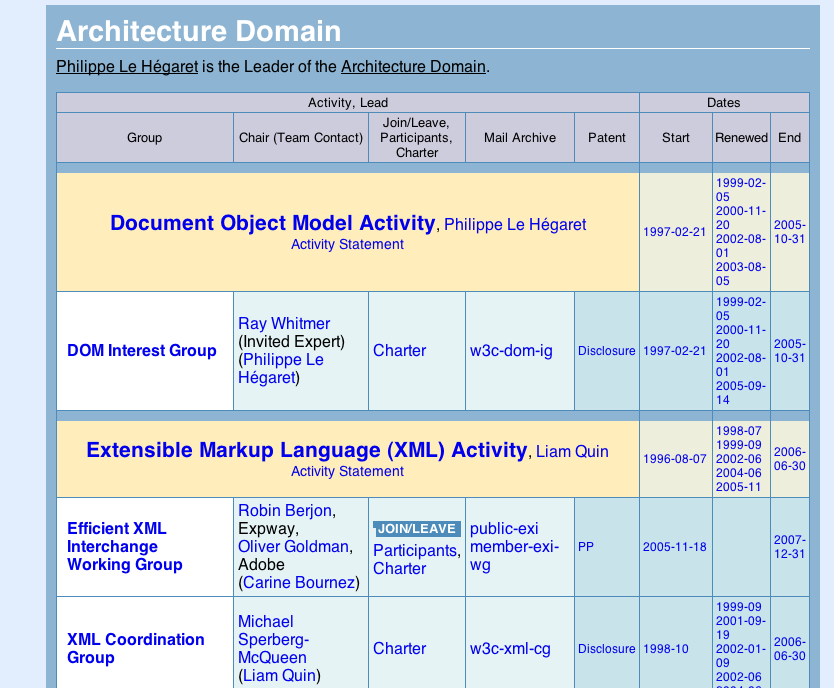
Some data built with RDF reported as HTML
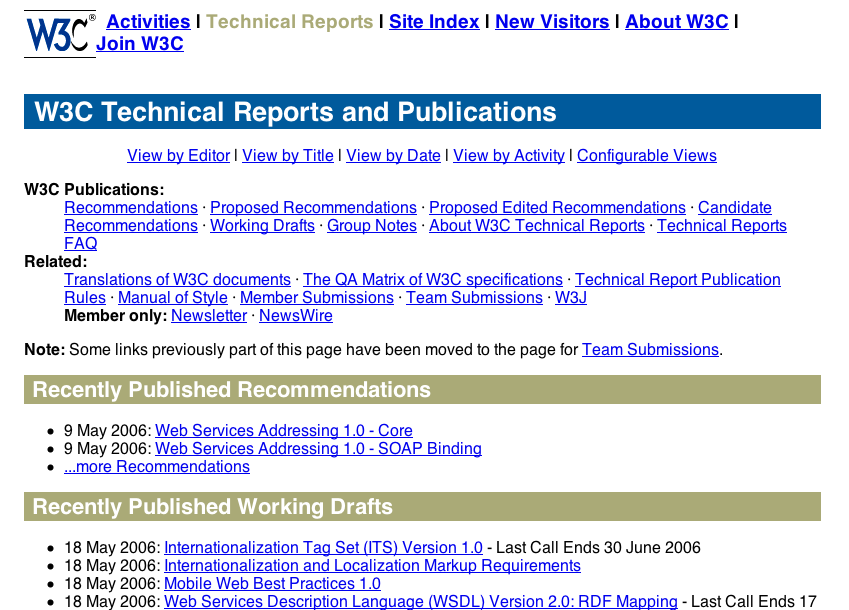
Tabulator: generic data browser

Starting only with a URI
Tabulating around W3C -

Tabulating around W3C -
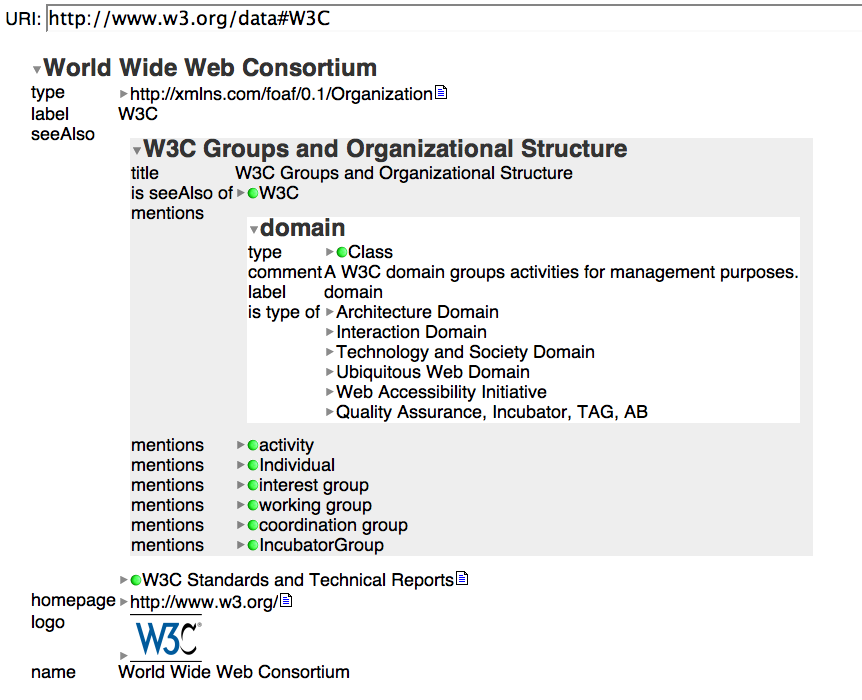
Tabulating around W3C -

Tabulating around W3C -
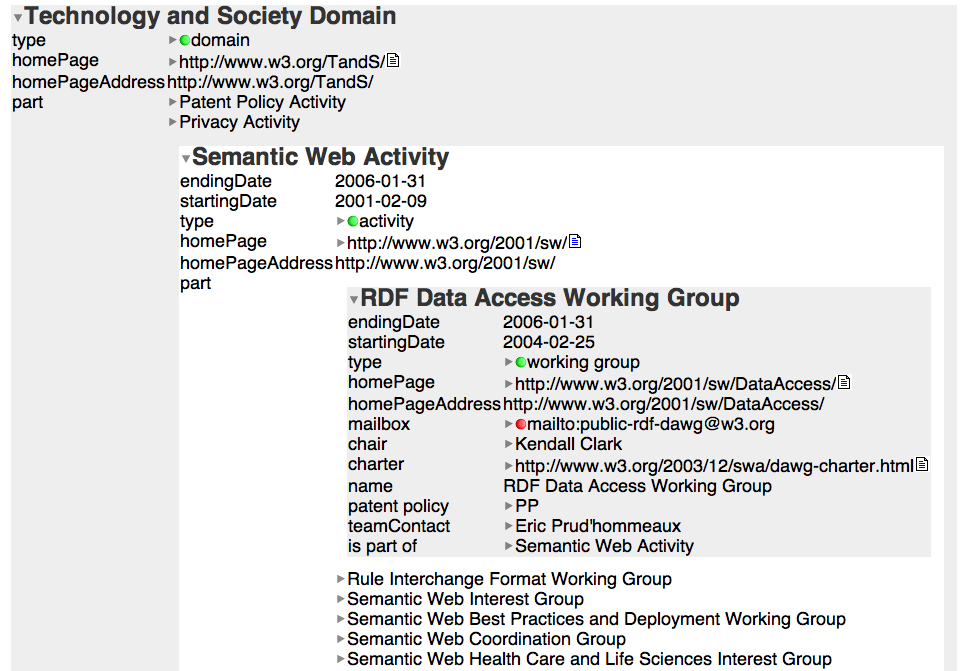
Tabulating around W3C - Crossing the application boundary
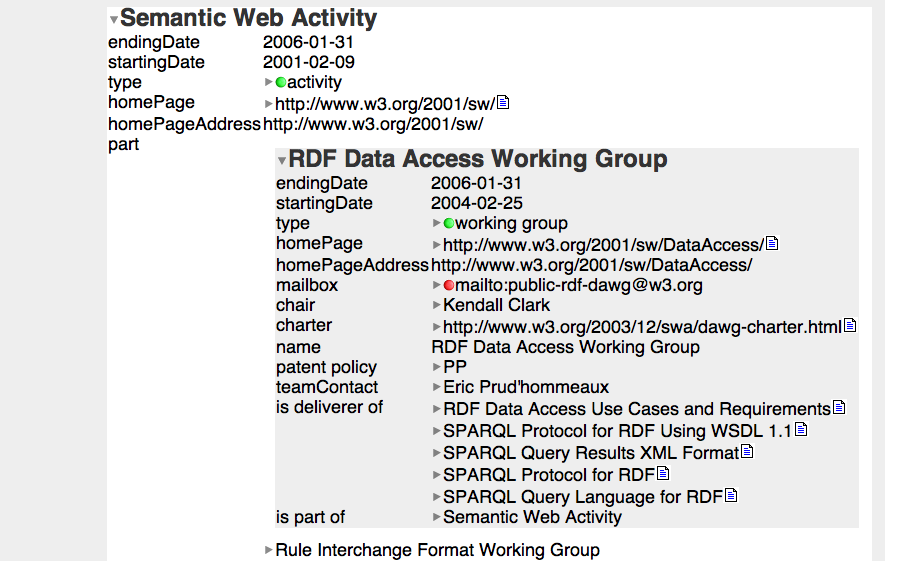
Tabulating around W3C -

Tabulating around W3C -
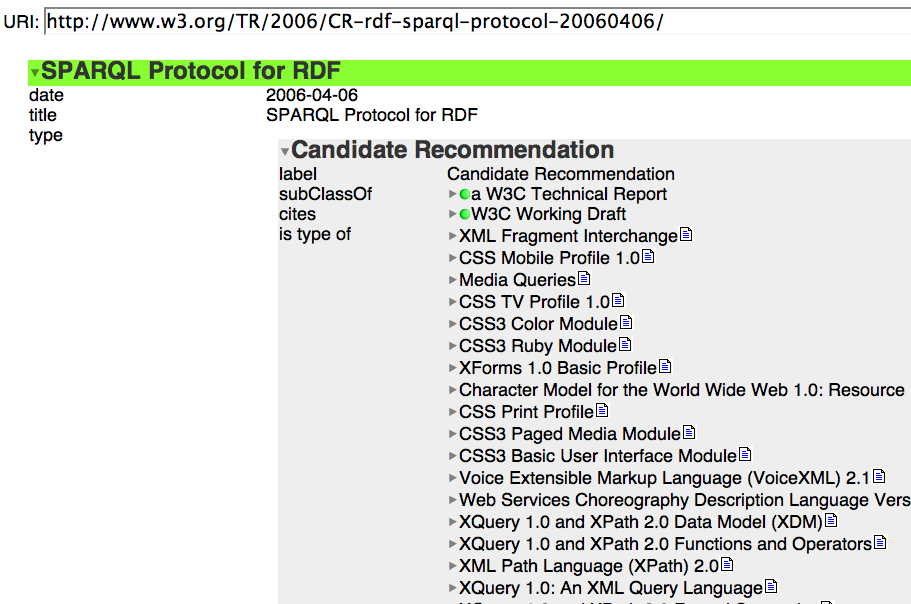
Tabulating around W3C - This is not a tree
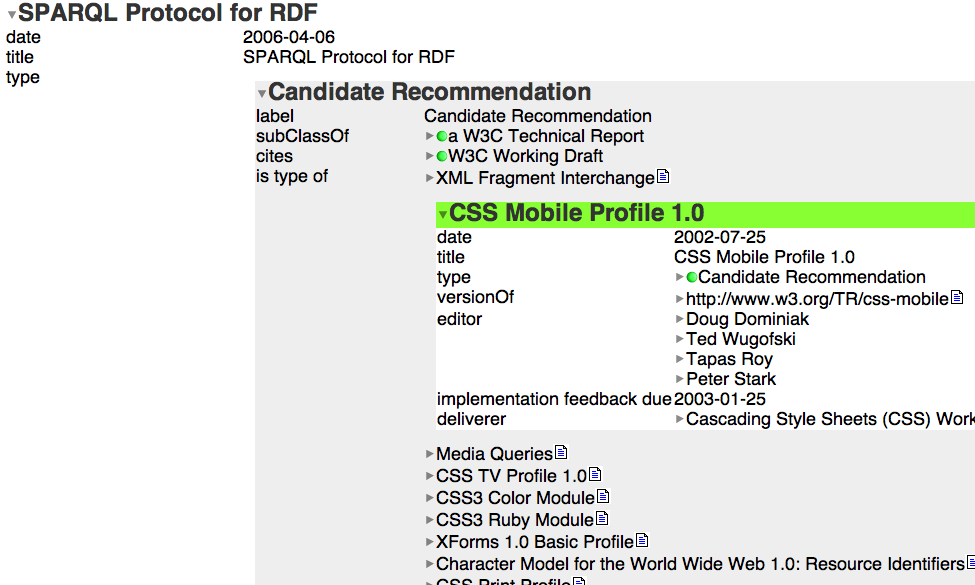
Tabulating around W3C - Query by example

Tabulating around W3C - Graph to table

Tabulator examples: Web, Time and Space
Tabulator: Select location fields
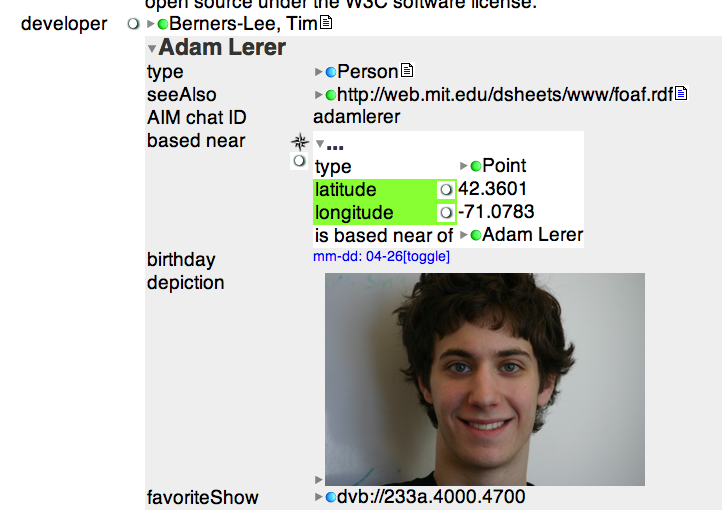
Tabulator: Find All patterns like this
pulling in data from the web as you go.
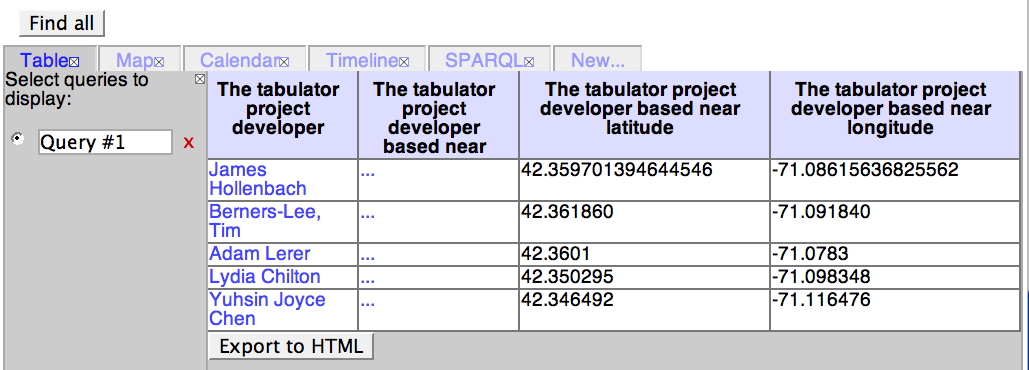
A table is the most compact, natural form for the user
Tabulator: Map view

Tabulator : Photos on a road trip

Tabulator: Select location and other data

Note selection at different levels of outline
Building an arbitrary query
Tabulator: Pull data into table

Tabulator: Map two things at once
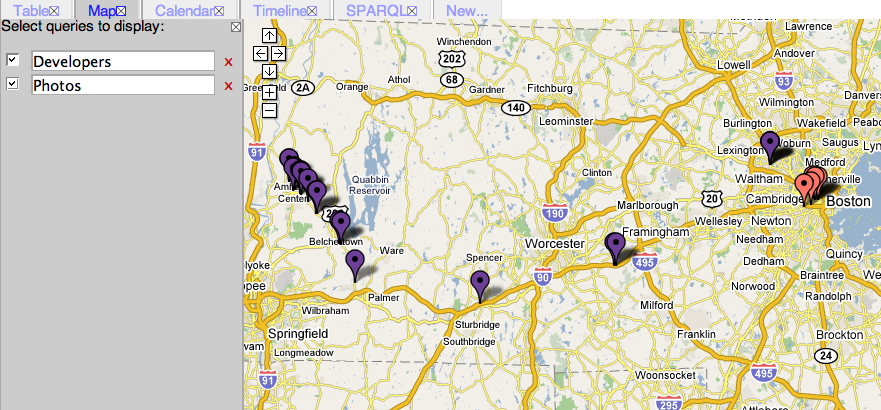
Tabulator: The Semantic Web at work
- Instant mash-up by user
- No application-specific programming
- Multiple datasets on the same map
- You can't do that with plain old XML.
Semantic Web software architecture
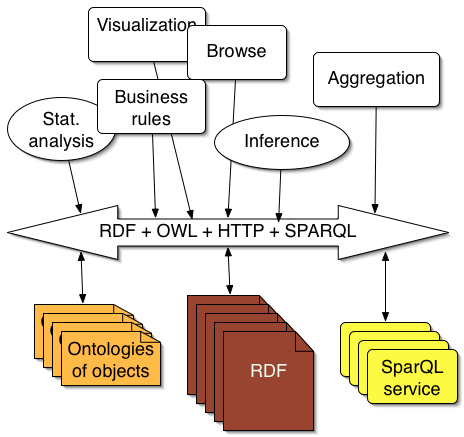
SW: Everything has a URI
Don't say "colour" say
<http://example.com/2002/std6#col>
Semantic Web Language stack
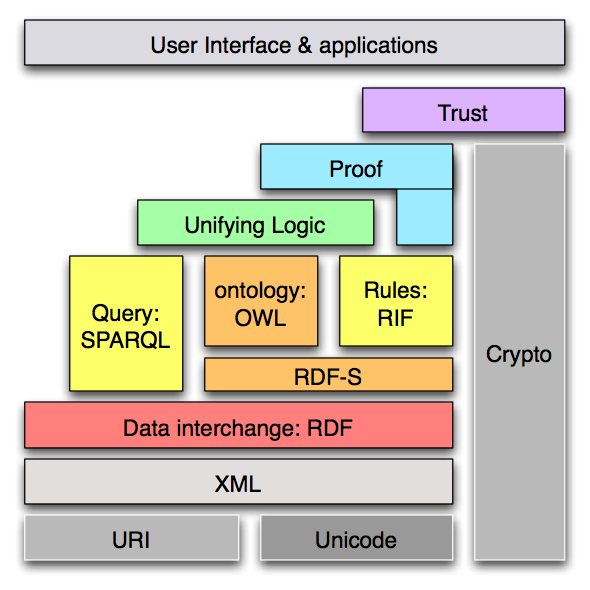
The element of the Semantic Web

- Can be encoded in XML
- Simplicity and mathematical consistency
- This is called Resource Description Framework (RDF)
Semantic web includes tables,...

...trees

... everything
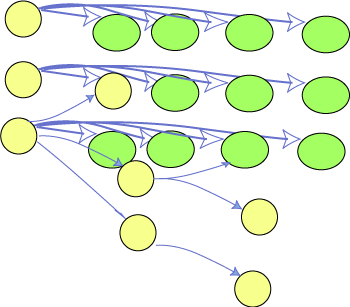
Applications connected by concepts
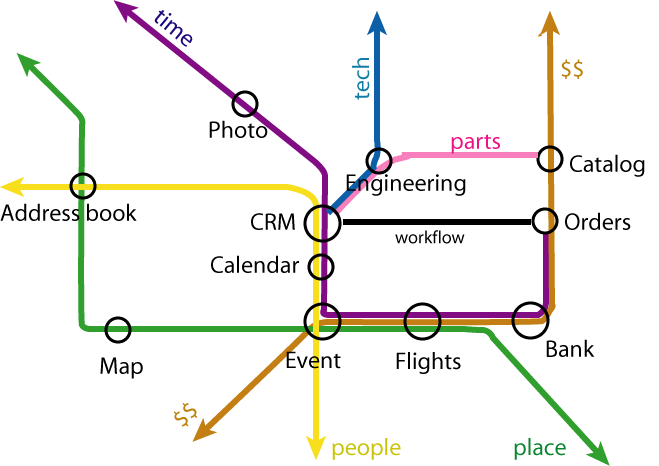
A single message
may contain information in RDF in, say,
- International terms: Date, time, lat/long
- International Financial terms (OFX, FPML etc)
- US SEC terms: XBRL etc
- Fidelity-Specific terms
- Fund-Specific terms
- Application-specific terms
Optimize reuse vs standardization effort
Data mixing: Term by term
| dc:title | Data Integration and Transparency |
| cc:license |
<http://creativecommons.org/licenses/by-nc/3.0/> |
| dc:creator |
| foaf:name | Tim Berners-Lee |
| foaf:homepage | <http://ww.w3.org/People/Berners-Lee> |
| foaf:email | <mailto:timbl@w3.org> |
|
| tk:event |
| dt:start | 2007-06-12T09:00 |
| dt:end | 2007-06-12T10:00 |
| dt:summary | W3C-WSRI eGovernment workshop |
| geo:lat | 38.9 |
| geo:long | -77 |
|
| tk:slides | <http://www.w3.org/2007/Talks/0618-egov-tbl> |
| tim:slideCount | 12 |
One item may involve data from many ontologies
Linked data
- Use URIs as names for things
- Funds http://id.fidelity.com/fund#FMSFX
- Companies http://nasdaq.com/id/
- People
- Filings
Transactions
- Use HTTP URIs so that people can look up
those names.
- When someone looks up a URI, provide useful
information.
- Include links to other URIs. so that they can discover
more things.
Examples of linked data
- Most ontologies
- Tool dbview-generated from SQL virtual RDF data
- Tool: D2R Server provides linked data as well as SPARQL
- FOAF (home brew, LiveJournal, Opera Community etc)
- dbpedia: Semantic wikipedia
- Geonames: Place-names ... etc
- See list
The biggest challenge is links to other systems
(Data browsers only: Fidelity,
FMAGX)
Semantic Web in Financial Services
- Information is the life blood of the business
- Deep, accurate, timely
- Connecting everything in one view
- Proactive creativity
- Rapid reaction to events
- Asking a question never asked before
Semantic Web in Financial Services (2)
Empowering financial managers
- Intranet Data
- Data from providers, Stock exchanges, etc
- Data to customers, SEC, etc
- Public data on companies, products, weather ..
Customer data browsing
- Pull Fidelity funds
- Pull competitor's funds
- Compare
- Drill down into one fund
- History
- Fund manager
- Her history
- Top 10 Stocks
- Their history...
- Company management
- Who they know
- Company green practices
- Other funds which invest in this company...
Integrating Fidelity data with non-Fidelity data
Two-layer architecture: Re-use by mashup community
- Core information providers provide data on the web
- All kinds of sites pick it up and re-purpose it in mash-ups
- Original provider benefits from availability of its data
- End-user benefits from creativity of mash-ups
- Mash-ups integrate data from many providers: Commercial, Govt, etc
Scenario: Transactions on the move
- Start transaction on laptop
- Continue on phone
- Switch from muse to voice
- Finish on screen in airport lounge
W3C Mobile Web Initiative: Device Independence
Scenario: Tax time
- IRS publishes rules in standard language
- Banks return data in standard RDF form
- All 1099s etc delivered in RDF
- I merge all the data I have
- I classify my transactions, press a button
- --> Tax information in RDF in 1040 ontology
Scenario: User data
Instead scraping other financial data for "FullView"
- Empower user to use Fidelity information at home or other sites
- Collect data in standard RDF form from other institutions
Conclusion
- Theme: Separating information from presentation
- RDF is a step change in interoperability from XML
Thank you for your attention
Web science - challenges

User Interface challenges
Domain-specific user interfaces are
blossoming... but what about generic ones?
- Generality: can browse any data anywhere
- Dynamically pick up from ontology: Lenses, style,
forms
- Independent control of: style, provenance, domains
(vocabulary groups)
- Blow spreadsheet tools away
Data policy challenges
- Identity
- Privacy
- Appropriate use
- Transparency
- Trust models
Resilience
- Internet breakage: Slashdotting
- Web breakage: Error 404
- Social breakage - Phishing etc
Challenge: New devices
- Great diversity
- Portable things
- Pixels everytwhere
- Developing countries
See W3C Mobile Web Initiative
Challenge: Intercreativity
- Creativity together
- Fractal groups
- New geography-free connectivity
- More intuitive interfaces
- New forms of democracy for difference cases
- Connection of half-formed ideas
Web Science: multidisciplinary
- Computer science
- Policy and Law
- Network engineering
- Economics
- Sociol Science
- Psychology
- Mathematics
- Media studies
- etc...
Web Science Research Initiative
- Getting people together
- Defining research areas
- Moving & funding students
- webscience.org

Thank You
More:
WSRI: webscience.org
W3C w3.org
Thank you for your attention
http://www.w3.org/2007/Talks/1003-webfuture-tbl/
Goals for humanity
- Curing disease - AIDS, Cancer, Alzheimer's
- Combatting poverty
- Combatting hunger
- Peace, Stable world governance
- Ecological sustainability
- Space
(e.g. compare UN Millennium Goals)
Collective capabilities:
- Collective Decision-making
- Creative solution and design
- Knowledge availability
How do we enhance these, assuming:
- In a fractal world of overlapping communities
- Much more powerful CPU, screen, net
- Complete data availability.






 Historical Roadmap
Web Science
Historical Roadmap
Web Science




























